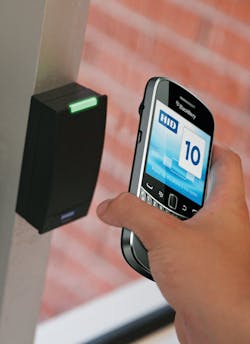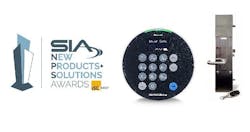Near field communication (NFC) is a standards-based connectivity technology for smart phones and similar type devices to provide contactless wireless connections and data exchange between two devices in close proximity. It is an evolution of the RFID technology. NFC can be interoperable, working with existing contactless card technology. It is inherently secure as the transmission range is short range, up to a few centimeters.
NFC is becoming a possible option for controlling access and making purchases using a device that has monetary and emotional value, a smart phone. Unlike an employee badge or student identification card, a smart phone has value to the owner. Not only does the telephone have a cost above and beyond the existing forms of identification cards and badges, but the emotional value and stored memories often far exceed a dollar amount.
Uses of an NFC-equipped smart phone include gaining access to home and office, logging onto computers, online banking, and online and “brick and mortar” merchandise purchases as well as paying for meals and theatre. Other advantages of smart phones include GPS capabilities, plus surfing the Internet for bus schedules, maps, etc.
A number of surveys have found similar results; a large percentage of high school and college aged students are very attached to their smart phones. They are never far away from their “phone”. This basically eliminates sharing. This mentality works well with the major problem of traditional access badges/ID cards; lost, loaned or forgotten.
There is a continuing effort by management to reduce the actual card costs and managing costs of badges and cards that are lost, forgotten, misplaced, need to be upgraded and employee departure. Most smart phone owners would be willing to use their personal phone as the NFC-enabled smart phone. This is advantageous; assigning the credential to a smart phone is significantly less expensive than preparing and delivering a personalized badge or ID card.
Student or employee provided smart phones will significantly drop the costs of providing and managing the credential. This will require almost universal compatibility. In addition, employees, students, etc., are significant less likely to misplace or forget their smart phone, greatly reducing the cost resulting from temporary access credentials.
Applications for Near Field Communications are staggering, according to the following recent news reports from all over the world.
Nearly A Third of Britons Want Mobile Payments Now
According to CBR Online, nearly a third of the United Kingdom consumers are “chomping at the bit” to use their smart phones to pay for goods and services, despite endless delays by the industry players in rolling out mobile payment platforms. NFC has long been available on credit and debit cards.
Samsung Staff to Get NFC ID
According to Daum.net, some 40,000 Samsung staff based at the headquarters in Suwon, South Korea, will begin using NFC phones instead of ID badges to gain access to buildings during the second half of 2012.
HID Global’s NFC pilot Completed at Arizona State University
The project at Arizona State University included RIM smart phones, Verizon Wireless and HID Global. Student could use the smart phones to open doors using digital credentials.
IR Security Technologies Tests at Villanova University
A select group of students are using NFC-enabled smart phones to gain access at Villanova. This pilot program is using the NFC-based mobile keys service developed by Ingersoll Rand Security Technologies in conjunction with student services provider CBORD. CBORD is a provider of campus ID card software for colleges and universities.
Spanish-based Salto Systems integrated NFC technology with their RFID locks equipped with MiFare protocol in 2006. At the international headquarters, employees are able to gain access using either a badge/ID card or their personal smart phone.
On March 26, 2012, Breg Insight presented a research report indicating that global sales of handsets featuring Near Field Communications increased ten-fold in 2011 to 30 million units. Other reports say that roughly half of the smart phones will be NFC enabled by 2015 or 2016.
Outside of the United States, the number of NFC-enabled smart phones is quickly becoming a significant percentage of the population with Europe has leading the way in wireless communications. Europe did not and does not have a telephony monolith, like Ma Bell, to lay down the vast copper and fiber network. As a result of the growth of the wireless network, the European acceptance and implementation of NFC technology in phones started about a decade ago.
Because of limited advertising and other factors, implementation in the United States is slow as the percentage of NFC enabled smart phones are not the majority. The majority of smart phones are purchased by and for those individuals more comfortable with technology. Practical implementation is waiting for the number of consumer owned smart phones to increase.
At this time, Apple has not publicly released an NFC enabled iPhone. For the United States market, it appears that Samsung, Nokia and RIM smart phones are equipped with NFC capabilities
A number of NFC enabled locks and readers are already in production as these security manufacturers are in process of introducing their interpretation of the NFC enabled access control. Depending upon the manufacturer, NFC enabled locks will be available using proprietary or open architecture based operating systems. NFC locks and readers install the same way as the RFID products.
However, NFC goes far beyond just controlling access. For many years, NFC enabled credit cards and smart phones have been used to make purchases. Companies like Google Wallet and MasterCard Pay Pass offer this technology. For Near Field Communication to be successful, smart phones must be able to do everything the owner wants.






